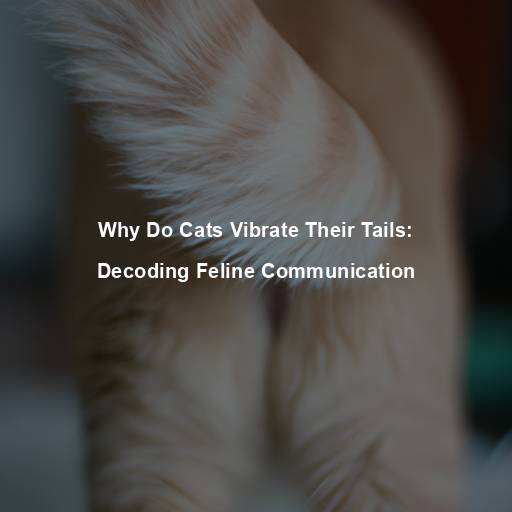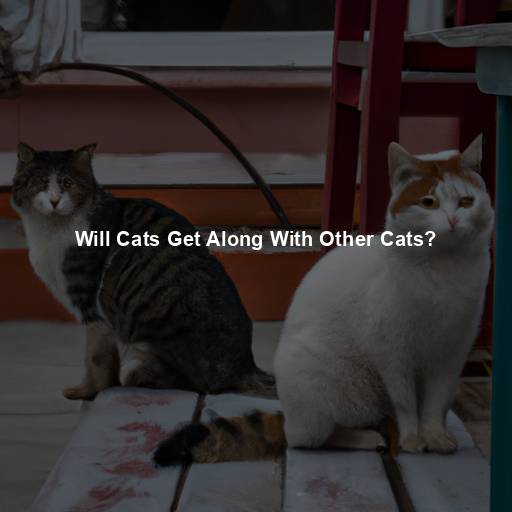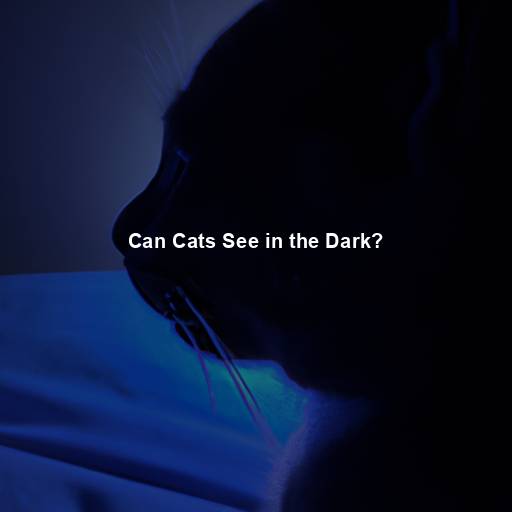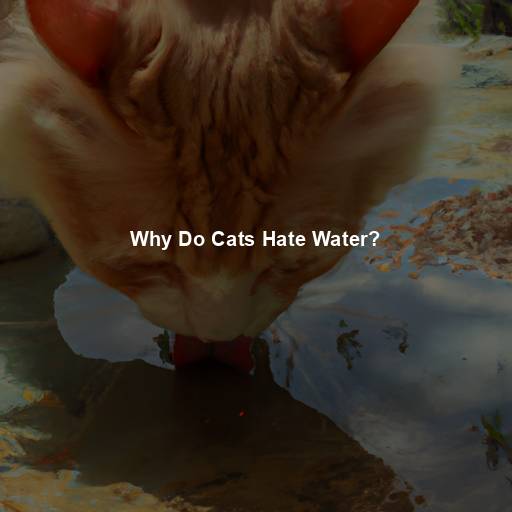Why Do Cats Vibrate Their Tails: Decoding Feline Communication
Last Updated on November 19, 2023 by Evan
Contents
- 1 Understanding Feline Communication
- 1.1 The Tail: A Window into a Cat’s Emotions
- 1.2 Understanding Tail Vibrations: The Basics
- 1.3 Expressing Contentment and Relaxation
- 1.4 Showing Affection and Happiness
- 1.5 Signaling Playfulness and Enthusiasm
- 1.6 Indicating Fear or Anxiety
- 1.7 Warning Signs of Aggression
- 1.8 Decoding Tail Vibrations: The Key to Understanding Your Cat
- 1.9 The Intricacies of Feline Communication
- 1.10 Decoding Tail Positions and Movements
- 1.11 The Multifaceted Language of Cats
- 1.12 Tail Vibrations in Different Breeds
- 1.13 The Language of Tail Vibrations
- 1.14 Tail Vibrations: A Window into Feline Emotions
- 2 FAQs – Why Do Cats Vibrate Their Tails?
- 2.1 What does it mean when a cat’s tail vibrates?
- 2.2 Why do cats’ tails vibrate when they are angry?
- 2.3 Do all cats vibrate their tails for the same reason?
- 2.4 Can a cat’s tail vibration indicate fear or anxiety?
- 2.5 Are tail vibrations in cats always a cause for concern?
- 2.6 How can I interpret a cat’s tail vibration correctly?
Understanding Feline Communication
Cats, those enigmatic creatures who constantly leave us curious and perplexed, possess a fascinating and mysterious language of their own. As devoted pet owners, it becomes our duty to navigate the intricate web of their signals, interpreting their thoughts, emotions, and intentions. Among the many baffling behaviors they exhibit, one that particularly captivates our attention is the mesmerizing tail vibration or trembling. In this captivating piece, we will venture into the depths of this enigma, unraveling the secrets behind feline communication and embarking on a journey that will leave us in awe of these furry little beings.
The Tail: A Window into a Cat’s Emotions
Feline enthusiasts often marvel at the astounding capabilities of a cat’s tail. This enigmatic appendage possesses a multitude of functions, far surpassing its simplistic appearance. One cannot help but be captivated by how it effortlessly aids cats as they gracefully traverse their environment, providing balance and poise. Furthermore, this versatile tail acts as a complex language, effortlessly conveying the myriad of emotions that cats experience, from exhilaration to trepidation, tranquility to ferocity, leaving us in a perpetual state of wonder and bewilderment.
Understanding Tail Vibrations: The Basics
One cannot help but be captivated by the enigmatic dance of the feline tail, known as “tail vibration” or “tail quivering”. This enigmatic behavior, characterized by an exquisitely rapid and rhythmic movement, is a silent language spoken only by our feline companions. While its meaning may mystify us at first, decoding this intriguing behavior is like unearthing the hidden emotions of our enigmatic feline friends.
Expressing Contentment and Relaxation
One of the most common reasons for tail vibrations in cats is a display of contentment and relaxation. When a cat is in a state of pure bliss, their tail may gently vibrate or tremble. This indicates that they are completely at ease in their environment, feeling safe and secure. Observing this behavior is a heartwarming sight, as it signifies that your feline companion is in a state of utmost comfort.
Showing Affection and Happiness
Cats, those enigmatic creatures of the feline kingdom, often perplex us with their contradictory behavior. While their independent streak is well-known, they also possess a hidden soft spot for their human counterparts. It is during those moments of seemingly inexplicable tail vibrations that their true colors shine through. Bursting with affection and happiness, these delightful feline friends are communicating their sheer joy and excitement upon sighting their beloved owners.
Signaling Playfulness and Enthusiasm
Prepare to be captivated by the mesmerizing behavior of our feline friends, as they unveil their playful enchantment and boundless energy. Watch in awe as their tails come alive with a symphony of vibrant vibrations, an undeniable invitation to partake in their whimsical games and exhilarating adventures. Allow yourself to be swept away by their rhythmic movements, a beautiful dance that reflects their uncontainable enthusiasm and insatiable desire for joy. Embrace the invitation and delve into a world of endless playfulness, where every moment is filled with delightful surprises and countless opportunities for laughter and connection.
Indicating Fear or Anxiety
Tail vibrations in cats can be intriguingly complex, revealing a spectrum of emotions that can leave even the most dedicated feline enthusiasts perplexed. Although commonly associated with happiness and contentment, these quivering tails can also serve as a signal of underlying fear or anxiety. In the enigmatic world of cat communication, it is vital to tune into subtle nuances, decoding the symphony of body language that accompanies these vibrating tails. Watch for telltale signs of distress, such as flat ears, expanded pupils, and an overall tense disposition, to accurately discern the true nature of these enigmatic vibratory gestures.
Warning Signs of Aggression
In some instances, tail vibrations can be a warning sign of an impending aggressive behavior. When a cat’s tail is rapidly vibrating or thrashing from side to side, it is best to exercise caution. This aggressive tail behavior is often accompanied by other visual cues such as flattened ears, hissing, or growling. It is essential to respect your cat’s boundaries and give them space until they feel more at ease.
Decoding Tail Vibrations: The Key to Understanding Your Cat
Unraveling the enigmatic world of feline communication goes far beyond deciphering the captivating movements of their tails. Fortunately, we’ve delved deeper into this captivating realm to help you forge an unbreakable bond with your beloved cat. Embark on this bewildering journey of connection with our expert tips, and prepare to unlock the secrets that lie within your feline’s mysterious language.
As you engage with your feline friend, take a moment to decode the intricate language they speak through their body. By closely observing the subtle vibrations of their tail, combined with a symphony of other signals like the positioning of their ears, the tones of their vocalizations, and the expressions on their face, a whole world of emotions becomes unraveled before you. Delve into the depths of their non-verbal communication and unlock the enigma of their feelings.
Understanding the intricacies of tail vibrations requires an astute consideration of various contextual factors. The enigmatic nature of these movements unveils a dynamic tapestry of meanings, intricately woven within the fabric of the situation at hand. By delving into the surrounding environment, recent events, and the formidable presence of fellow creatures, one can embark on an exhilarating quest to unravel the elusive intentions conveyed through these subtle yet significant gestures.
When it comes to our feline friends, it’s important to remember that they are their own purr-son with their own quirks and preferences. Just like humans, cats have personal boundaries that should be respected. If you notice your cat displaying signs of discomfort or aggression, it’s best to give them some space and avoid trying to force interactions.
When it comes to deciphering your feline companion’s enigmatic behaviors and ensuring their utmost welfare, it’s essential to consult the expertise of professionals in the field. Veterinarians and certified animal behaviorists possess a wealth of knowledge and experience that can shed light on the perplexing intricacies of your cat’s conduct. With their tailored insights and invaluable guidance, you can navigate the labyrinth of uncertainties surrounding your furry friend’s well-being and pave a path towards harmony and understanding.
The Intricacies of Feline Communication
Cats possess a rich and complex communication system that extends beyond tail vibrations. By immersing ourselves in their world and actively listening to their cues, we can forge a deeper bond with our feline companions. From tail flicks to purrs, meows to chirps, each aspect of their communication adds to the tapestry of our shared language.
Remember, building a strong relationship with your cat takes time, patience, and understanding. Embrace the mysteries of their tail vibrations and embark on a journey of mutual trust and companionship. As we unravel the secrets of feline communication, let us celebrate the extraordinary bond we share with these enigmatic creatures who have captured our hearts and souls. ## Unraveling the Tail Vibrations: Further Insights
Decoding Tail Positions and Movements
While tail vibrations provide valuable insights into a cat’s emotions, it is equally important to understand the significance of different tail positions and movements. By observing these cues, we can enhance our understanding of feline communication.
Upright Tail Position
An upright tail position indicates a cat’s confidence and assertiveness. When a cat holds its tail high in the air, it signifies a self-assured and contented state. This is often observed when a cat is exploring its territory, feeling secure in its surroundings.
Lowered Tail Position
The position of a cat’s tail can reveal a spectrum of emotions, adding a mysterious layer to their feline complexities. When a cat’s tail is held low and close to the ground, it could signal a range of sentiments, from submission to fear, especially when accompanied by telltale signs of anxiety like flattened ears or a crouched posture. Conversely, a languidly lowered tail, exhibited in a relaxed and carefree manner, may indicate a state of tranquility and contentment that leaves us humans mesmerized by their enigmatic nature.
Puffed-up or Bushy Tail
A puffed-up or bushy tail is a clear indication of a cat feeling threatened or frightened. This involuntary response, known as piloerection, makes the cat appear larger and more intimidating. It is often accompanied by an arched back and an aggressive stance as a defense mechanism.
Tail Twitching
Cats, those enigmatic creatures, possess an intriguing method of communication through the art of tail twitching. Behold, for their tails serve as a secret code, revealing a multitude of messages. Pay heed to the delicate dance of a slow and gentle twitch, oh curious one, for it hints at their unyielding curiosity and indomitable focus. Yet, beware the furious flurry of a rapid and vigorous twitch, dear wanderer, for it signifies their annoyance and restless agitation.
The Multifaceted Language of Cats
While tail vibrations play a significant role in feline communication, it is important to recognize that cats utilize a wide range of vocalizations, body postures, and facial expressions to express themselves. By integrating our understanding of tail vibrations with these other forms of communication, we can further decipher the complex language of cats.
Vocalizations
When it comes to communication, cats are like a whole symphony of sounds. Whether they’re purring in contentment or letting out demanding meows, trills, chirps, yowls, and hisses, every sound they make serves a specific purpose. Decoding these meows and mews can offer us a glimpse of their emotional state and what they’re trying to convey. So, the next time your feline friend starts their melodic serenade, pay close attention to their tone and context to unlock the mysteries of their furry language.
Facial Expressions
Have you ever noticed how expressive a cat’s face can be? It’s fascinating how their tails aren’t the only cue to their emotions. By observing the subtle movements of their ears, the size of their pupils, and the tension in their facial muscles, we can unravel a feline’s mysterious mood. Those relaxed eyes, with a slight hint of closure or the occasional blink, speak volumes about their contentment, while those wide-open eyes with dilated pupils hold the secrets of their fear or excitement.
Body Postures
Cats, those enigmatic creatures of mystery and intrigue, have an often bewildering array of body language at their disposal to convey their innermost thoughts and feelings. Their postures are like an intricate dance, revealing a kaleidoscope of emotions to those who can decipher them. When a feline lowers its body close to the ground, tail retreated between its legs, a tidal wave of fear or submissiveness may be washing over it. Yet, if its back curves into a graceful arch and its tail stands tall, a potent mix of aggression or defensiveness may be brewing beneath the surface.
Tail Vibrations in Different Breeds
When it comes to cats and their tail shenanigans, things can get quite intriguing. Not only do various cat breeds have their own unique style of tail communication, but certain physical attributes can also come into play. For instance, take the Japanese Bobtail with its adorable short and curly tail – this characteristic alone brings an interesting twist to their tail movements. Moreover, breeds like the Maine Coon or Siberian, blessed with fluffy and voluminous tails, take the visual impact of tail vibrations to a whole new level.
The Language of Tail Vibrations
Cats possess a remarkable ability to communicate through tail vibrations, providing us with a glimpse into their inner world. While we have explored the various emotions and messages conveyed by this behavior, it is important to delve deeper into the nuances of feline communication.
Tail Position and Movements
In addition to tail vibrations, the position and movements of a cat’s tail can reveal valuable information about their mood and intentions. Understanding these cues can greatly enhance our comprehension of feline communication.
- Upright Tail Position: An upright tail position signifies confidence and contentment. When a cat holds its tail high in the air, it indicates a state of self-assurance and comfort. This can often be observed when a cat is exploring its territory, feeling secure in its environment.
The position of a dog’s tail can reveal a world of emotions, fascinatingly complex and nuanced. When the tail is held closer to the ground, it can symbolize numerous sentiments, its meaning contingent upon the context. In some cases, it may signal submissiveness or fear, especially when accompanied by additional signs of anxiety, like flattened ears or a crouched stance. Conversely, a tail that is relaxed and loosely lowered can be a telltale sign of a tranquil and content state of mind.
-
Puffed-up or Bushy Tail: A puffed-up or bushy tail is a clear indication of a cat feeling threatened or frightened. This response, known as piloerection, makes the cat appear larger and more intimidating as a defense mechanism. It is often accompanied by an arched back and an aggressive stance.
-
Tail Twitching: Tail twitching is another behavior that cats exhibit, which can convey different messages depending on the speed and intensity of the twitching. A slow and gentle twitch can indicate curiosity or focus, while a rapid and vigorous twitch can signify annoyance or agitation.
Vocalizations: Meows, Purrs, and More
Cat tail movements are not the only form of communication in their vast repertoire. Their voices also play an important role in expressing their emotions and desires. From gentle meows to intense hisses, each vocalization conveys a unique message that reflects their needs and feelings.
Cats have a unique way of expressing their needs and desires through a delightful repertoire of meows. From the subtle purr to the passionate yowl, these feline vocalizations convey an array of messages, signaling everything from hunger to a longing for affection. The melody and intensity of their meows offer fascinating insights into their emotional state, offering a symphony of sounds that captivate and perplex us humans. So, the next time you hear your furry friend meowing, take a moment to decipher the mysterious melody and unlock their secret desires.
Purring, that comforting rumbling sound that emanates from our feline companions, holds a fascinating duality. We often equate it with a state of tranquility and bliss, a testament to their feelings of security and ease. Yet, let us not be deceived by its serene facade, for purring can also be a cryptic messenger, hinting at whispers of discomfort and anxiety lurking deep within. Decoding the enigmatic language of purrs requires a careful examination of the accompanying body cues, unearthing the mysteries that lie beneath this paradoxical symphony.
Cats have this fascinating way of communicating with us, using trills and chirps that are like a secret language. These enchanting vocalizations, filled with warmth and melody, serve as their way of greeting humans or other furry friends. And the magical part? These sweet sounds often come hand-in-hand with subtle tail vibrations, creating an utterly adorable symphony of connection and affection.
- Yowls and Hisses: Yowls and hisses are vocalizations associated with aggression, fear, or territorial disputes. These intense sounds serve as warnings and are accompanied by defensive body postures.
Body Postures: Reading the Silent Gestures
The captivating world of felines never ceases to amaze us. Through their intricate repertoire of body postures, enchanting facial expressions, and mesmerizing body language, cats unveil a whole universe of untold emotions and mysterious intentions. Dive into the enigmatic realm of our feline companions, where every stance reveals a secret, and every gaze holds a hidden message waiting to be deciphered.
Have you ever wondered what your feline friend is really feeling? Well, it turns out that their ears hold the key to unlocking their emotions. When those little ears are pointing straight ahead, it means your cat is fully engaged and curious about the world around them. But beware of the flattened ears, as they can be a telltale sign of fear, anger, or even a plea for peace.
The enigmatic allure of a cat lies within its eyes, a gateway into a world of mystery and emotions. One moment, wide open with dilated pupils, revealing a mixture of fear, excitement, and arousal. The next, relaxed and slightly closed, with gentle blinks that speak volumes of contentment and trust. The feline gaze, an enigmatic masterpiece that invites us to decipher its secret language.
Whiskers, the mysterious and delicate vibrissae of feline companions, possess an enigmatic ability to decode the world around them. In their natural state, when elegantly poised forward, they whisper tales of tranquility and contentment. Yet, when clandestinely tucked tight against their graceful visage, a hidden story of apprehension or ferocity emerges, shrouded in a veil of intrigue and wonder.
- Body Posture: A cat’s overall body posture can convey a range of emotions. A relaxed, loose stance signifies contentment, while a tense, hunched posture may indicate fear or aggression. Arched backs are often associated with defensive or aggressive behaviors.
Tail Vibrations: A Window into Feline Emotions
Tail vibrations are an integral part of a cat’s communication toolkit, providing valuable insights into their emotions, desires, and boundaries. By integrating our understanding of tail vibrations with vocalizations, facial expressions, and body postures, we can better comprehend the intricate language of cats.
Understanding our feline friends’ communication cues is an essential aspect of being a responsible pet owner. In honoring this duty, we can forge a profound bond that nurtures trust, fosters understanding, and ultimately cultivates an environment in which our beloved cats can truly flourish. Together, let’s embark on a journey of exploration into the enigmatic world of feline communication, unlocking the secrets behind those perplexing purrs, mysterious meows, and enigmatic gestures. By embracing our role as caregivers, we can create an extraordinary connection with these fascinating creatures, unravelling the complexities of their language and opening a gateway to a deeper level of understanding.
When you catch sight of your feline companion’s tail in a state of vibration, seize the opportunity to witness the intricate language they convey through their entire body, take heed of the sounds they emit, and delve into the circumstances surrounding the moment. By immersing yourself in this mindful exploration, you will embark on a captivating expedition, unraveling the enigmatic world of feline communication, and cultivate an even more profound bond with your cherished furry friend.
FAQs – Why Do Cats Vibrate Their Tails?
What does it mean when a cat’s tail vibrates?
The enigmatic dance of a cat’s tail holds a tapestry of intricate meanings, entwining us in a web of curiosity. One moment, it shivers like a leaf in the wind, a shimmering reflection of its exhilaration and heightened senses. Perhaps it is the promise of playful encounters or the anticipation of gentle caresses that sets its tail ablaze, palpable excitement coursing through its delicate form. Yet, in the realm of hunting, its tail becomes a quivering rudder, guiding its predatory instincts with a mesmerizing rhythm. And within these mysterious gestures lies the veil of feline communication, an enigmatic language known only to the intrepid and the astute.
Why do cats’ tails vibrate when they are angry?
The enigmatic world of feline communication never ceases to bewilder us. In those mysterious moments of vexation and displeasure, a cat’s tail unveils a captivating dance of emotions. A slight quiver, a subtle tremor, and we enter a realm where anger and aggression intertwine with caution and self-preservation. As the tail vibrates, it is a compelling semaphore that whispers of potential threats and an imminent defensive stance. However, let us not be too hasty in our assumptions! To decode the enigma of a cat’s tail, we must unravel the tapestry of their entire body language and unravel the perplexing weave of their surroundings.
Do all cats vibrate their tails for the same reason?
No, not all cats vibrate their tails for the same reason, as tail vibrations can vary depending on the individual cat and the situation. Cats have different temperaments and personalities, so their tail behaviors can differ. Some cats may vibrate their tails when they are excited, while others do it when they are angry or frightened. Understanding an individual cat’s body language and behavior patterns is crucial in determining the reason behind tail vibrations.
Can a cat’s tail vibration indicate fear or anxiety?
Yes, tail vibrations in cats can sometimes be a sign of fear or anxiety. When a cat feels threatened or scared, it may vibrate its tail as part of its fear response. It is important to pay attention to other accompanying signs such as flattened ears, dilated pupils, or attempts to hide. If a cat consistently exhibits fearful or anxious behavior, it is recommended to provide a safe and comfortable environment and consider consulting with a veterinarian or animal behaviorist.
Are tail vibrations in cats always a cause for concern?
There’s more to that tail than meets the eye. While we may jump to the conclusion that tail vibrations are always a red flag, it’s not always the case. In the elusive world of feline communication, these tremors can actually convey a range of emotions, from the joy of playtime to the thrill of anticipation. So, before you raise the alarm bells, take a step back and observe the bigger picture – the cat’s body language and the context – to truly decipher the message hidden in those vibrant tail vibrations.
How can I interpret a cat’s tail vibration correctly?
Understanding the intricate language of a cat’s tail wagging goes beyond just observing the rhythmic movements. It’s a perplexing code that demands a holistic approach, taking into consideration a multitude of factors. From the cat’s bodily stance to its expressive face, the position of its ears, the melody of its vocalizations, and the broader context of its behavior, each piece of the puzzle must be pieced together for a comprehensive interpretation. Moreover, developing a deep familiarity with your own cat’s idiosyncrasies and inclinations will further enhance the deciphering process, allowing for more meaningful interaction and communication with your furry companion.







